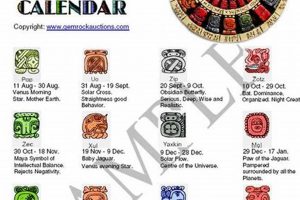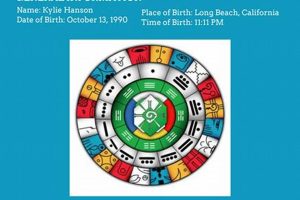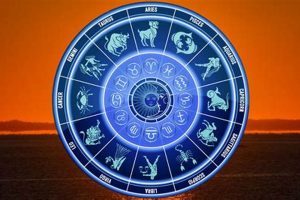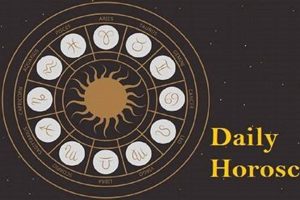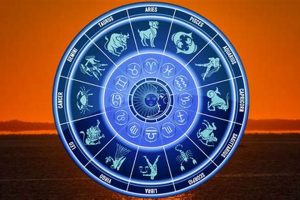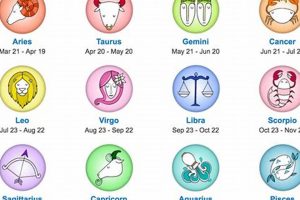Within the Mesoamerican belief system, each day carries a unique energetic signature derived from the complex interplay of the Tzolkin and Haab calendars. The Tzolkin, a 260-day sacred calendar, combines 20 day signs with 13 numbers to create a cycle of distinct energies. The Haab, a 365-day solar calendar consisting of 18 months with 20 days each and a five-day period known as Wayeb, reflects the annual cycle of seasons. An individual’s birth date within these interwoven calendars determines their corresponding day sign and associated characteristics, providing insights into personality, strengths, and life path. For instance, someone born on a day associated with the day sign Imix might be seen as nurturing and foundational, while someone born under the sign of Ik might be associated with breath, life force, and connection to the divine.
Understanding these calendrical influences offers a framework for self-discovery and navigating life’s challenges. By recognizing the energies associated with one’s natal day, individuals can gain a deeper understanding of their inherent nature and potential. This perspective is not predictive, but rather offers a lens through which to view one’s strengths, weaknesses, and karmic patterns. Historically, these calculations served as a vital tool for Mayan communities, informing decisions related to agriculture, ceremonies, and even relationships. The enduring relevance of this system reflects its profound connection to the cycles of nature and the human experience.
This article will explore the intricacies of the Mayan calendar system, delve into the individual day signs and their associated meanings, and provide guidance on how to determine one’s own placement within this rich astrological tradition. Furthermore, it will examine the practical applications of this knowledge for personal growth and spiritual development.
Tips for Understanding Your Mayan Astrological Sign
These tips offer practical guidance for exploring the significance of one’s birth date within the Mayan calendar system.
Tip 1: Accurate Date Conversion: Precise calculation requires converting the Gregorian calendar birth date to the corresponding Tzolkin and Haab day signs. Several online resources and dedicated software programs facilitate accurate conversion. Due to the complexities of the calendar systems, manual calculation can be challenging.
Tip 2: Beyond the Day Sign: While the day sign provides foundational insights, a comprehensive understanding involves considering the associated number and its influence. For example, a day sign combined with the number 7 might amplify its inherent qualities, while a combination with the number 1 might represent new beginnings or leadership.
Tip 3: Embrace Nuance: Interpretations should avoid rigid definitions. Each day sign encompasses a spectrum of potential traits and expressions. Consider these interpretations as guides for self-reflection, not absolute pronouncements.
Tip 4: Explore Interwoven Influences: The combined influence of the Tzolkin and Haab provides a more complete picture. Understanding the interplay of these two calendars offers a deeper understanding of one’s energetic blueprint.
Tip 5: Consult Reputable Sources: Seek information from scholars and practitioners specializing in Mayan cosmology. Reliable resources often draw upon both historical texts and contemporary understanding.
Tip 6: Practical Application: Integrating this knowledge into daily life can enhance self-awareness. Reflect on the characteristics associated with one’s day sign and explore how these resonate with personal experiences and relationships.
Tip 7: Continual Learning: The study of Mayan astrology is a lifelong journey. Continued exploration and deeper engagement with the material can yield richer insights over time.
By following these tips, individuals can gain valuable insights into their inherent strengths, challenges, and life path. This understanding promotes self-acceptance, empowers informed decision-making, and fosters a deeper connection to Mayan ancestral wisdom.
This exploration concludes with a reflection on the enduring significance of Mayan astrology and its potential to enrich contemporary lives.
1. Tzolkin Calendar
The Tzolkin calendar forms the cornerstone of Mayan astrology, serving as the foundation for understanding one’s energetic blueprint. This sacred 260-day calendar, distinct from the solar Haab calendar, represents a cycle of interconnected energies influencing personality, life path, and spiritual development. Its structure comprises 20 unique day signs, each carrying symbolic meaning, combined with the numbers 1 through 13. This cyclical interplay creates 260 distinct combinations, each imbuing a specific day with a particular energetic signature. One’s birth date, converted to its corresponding Tzolkin day sign and number, unveils profound insights into inherent strengths, challenges, and karmic predispositions. For example, a birth date corresponding to the day sign Ahau, associated with leadership and enlightenment, coupled with the number 8, signifying harmony and balance, suggests an individual with the potential for insightful leadership tempered by a strong sense of justice and equilibrium.
The Tzolkin calendar’s significance extends beyond individual interpretation. It functioned as a vital tool for Mayan communities, guiding agricultural cycles, ceremonial practices, and communal decision-making. The calendar’s cyclical nature reflects the Mayan worldview, emphasizing interconnectedness and the cyclical flow of time and energy. Its continued relevance stems from its capacity to provide individuals with a deeper understanding of their intrinsic nature and purpose, fostering self-awareness and informed life choices. Furthermore, understanding the Tzolkin calendar unlocks deeper levels of meaning within Mayan cosmology, revealing the intricate relationship between humanity and the cosmos.
The Tzolkin calendar, therefore, acts as a crucial key to unlocking the wisdom embedded within Mayan astrology. Its influence pervades all aspects of understanding one’s energetic signature, offering a profound framework for self-discovery and navigating life’s complexities. Challenges in interpreting the Tzolkin often arise from the intricacies of calendar conversion and the nuances of symbolic interpretation. However, dedicated study and engagement with reputable sources can yield significant insights into the enduring wisdom of this ancient system, allowing individuals to tap into a deeper understanding of themselves and their place within the universe.
2. Haab Calendar
The Haab calendar, a 365-day solar calendar, plays a crucial role in understanding the nuances of a Mayan astrology birth date. While the Tzolkin calendar provides the energetic blueprint through its 260-day cycle, the Haab grounds this energy within the earthly realm, reflecting the annual cycle of seasons and agricultural rhythms. Comprised of 18 months of 20 days each, plus a five-day period known as Wayeb, the Haab aligns with the solar year, providing a practical and observable framework for understanding cyclical changes in nature. This connection to the natural world adds a layer of depth to interpretations of birth dates, associating individuals with the specific energies of the season in which they were born. For example, someone born during the month of Mol, associated with water and rain, might exhibit a fluidity and adaptability in their character. When combined with the Tzolkin day sign, the Haab further refines the individual’s energetic signature, providing a more comprehensive understanding of their inherent predispositions. This intersection of the sacred and the earthly offers a unique perspective on individual destinies within the larger context of the natural world.
The practical significance of the Haab calendar within Mayan astrology lies in its ability to contextualize the energetic influences of the Tzolkin within the tangible cycles of the natural world. This interplay creates a more nuanced understanding of one’s birth energy. For instance, if an individual’s Tzolkin day sign is Kan, associated with the seed and new beginnings, and their Haab birth month is Zip, associated with deer hunting and masculine energy, the combined influence might suggest someone who initiates new ventures with a focused and assertive approach. The Haab calendar also provides insights into auspicious timing for various activities, aligning actions with natural rhythms to maximize potential outcomes. This practical application resonates with the Mayan worldview, which emphasizes the interconnectedness of human life with the natural order. Understanding the interplay of both calendars, therefore, offers a richer and more complete interpretation of a Mayan astrology birth date.
In summary, the Haab calendar provides the earthly context for the energetic influences defined by the Tzolkin calendar within Mayan astrology. Its connection to the solar year and agricultural cycles provides a tangible link between individual destinies and the natural world. While challenges exist in accurately correlating the Haab and Tzolkin calendars due to historical discrepancies and complex conversion methods, the integration of both calendars offers a more profound understanding of the energetic influences shaping one’s birth date. This synthesis of sacred and practical perspectives provides a unique lens for self-discovery and informed decision-making, allowing individuals to align their actions with the natural rhythms of life and maximize their inherent potential.
3. Day Sign (glyph)
Within Mayan astrology, the Day Sign, represented by a unique glyph, serves as the foundation for understanding the energetic influences shaping an individual’s birth date. Derived from the Tzolkin calendar, the 20 Day Signs represent archetypal energies that influence personality, strengths, weaknesses, and life path. Each glyph carries specific symbolism, deeply rooted in Mayan cosmology and mythology, offering profound insights into one’s inherent nature.
- Symbolic Meaning
Each Day Sign possesses a unique symbolic meaning, representing a specific archetype or force of nature. Imix, for example, symbolizes primordial waters and creation, while Chicchan embodies the life-sustaining force of serpents and lightning. Understanding the symbolism associated with one’s Day Sign provides a framework for interpreting its influence on personal characteristics and life experiences. These symbolic meanings are not fixed interpretations but rather offer a lens through which to explore one’s potential and navigate life’s challenges.
- Influence on Personality
The Day Sign is believed to influence various aspects of personality, including temperament, strengths, and weaknesses. Individuals born under the sign of Oc, for instance, might exhibit strong leadership qualities and a drive for achievement, whereas those born under Men might be more inclined towards artistic expression and introspection. While the Day Sign does not define an individual’s entire personality, it provides insight into core motivations and behavioral patterns, offering a framework for self-awareness and personal growth.
- Connection to the Divine
Mayan cosmology emphasizes a deep connection between humanity and the divine forces permeating the universe. Each Day Sign embodies a specific aspect of this divine energy, linking individuals to particular deities or cosmic principles. For example, the Day Sign Ahau connects individuals to the sun god and embodies themes of leadership and enlightenment. This connection to the divine provides a sense of purpose and belonging within the larger cosmic order.
- Interaction with Numbers and Haab
The Day Sign’s influence is further nuanced by its interaction with the numbers 1 through 13 in the Tzolkin calendar and the associated month within the Haab calendar. The number combined with the Day Sign adds another layer of interpretation, amplifying or modifying its inherent qualities. The Haab month provides an earthly context, linking the Day Sign’s energy to the natural rhythms of the solar year. This interplay of factors creates a complex and individualized energetic signature for each birth date, offering a more comprehensive understanding of one’s unique path.
By understanding the symbolism, personality influences, and cosmic connections associated with one’s Day Sign, individuals can gain valuable insights into their inherent nature and potential. This knowledge empowers self-reflection, informed decision-making, and a deeper connection to Mayan ancestral wisdom. While exploring one’s Day Sign provides a foundation for understanding a Mayan astrology birth date, further exploration of the interconnected elements within the Mayan calendar system deepens the understanding of this complex astrological tradition.
4. Number (1-13)
Within the Mayan Tzolkin calendar, the numbers 1 through 13 hold significant weight in interpreting a Mayan astrology birth date. These numbers are not merely sequential but represent distinct energetic influences that intertwine with the 20 Day Signs to create the 260 unique combinations within the calendar. Understanding the energetic qualities associated with each number provides a deeper layer of interpretation, refining the insights offered by the Day Sign and contributing to a more nuanced understanding of one’s energetic blueprint. The number associated with one’s birth date, therefore, plays a crucial role in shaping the overall interpretation within Mayan astrology.
- Energetic Qualities
Each number carries its own specific energetic resonance, contributing to the overall interpretation of the birth date. For instance, 1 represents unity, beginnings, and leadership, while 7 signifies reflection, introspection, and spiritual awareness. These energetic qualities interact with the Day Sign, modifying and refining its inherent characteristics. Therefore, understanding the specific energy of one’s birth number offers further insight into potential strengths, challenges, and life path.
- Cycles of Creation and Destruction
The 13 numbers represent cycles of creation, growth, and transformation. As the numbers progress from 1 to 13, they symbolize the stages of development, culminating in completion and renewal. This cyclical nature reflects the Mayan worldview of continuous cycles of birth, death, and rebirth. The specific number within one’s birth date provides insights into their current position within this larger cycle, suggesting potential lessons and opportunities for growth.
- Interaction with Day Signs
The interaction between the number and the Day Sign creates a dynamic interplay of energies that shapes the overall interpretation. The number can amplify certain aspects of the Day Sign or introduce nuances that refine its expression. For example, the Day Sign Imix, associated with primal waters and creation, combined with the number 1, might signify a powerful creative force focused on new beginnings, while Imix combined with the number 7 might suggest a more introspective and spiritual approach to creativity. Therefore, the number acts as a modifier, refining and individualizing the influence of the Day Sign.
- Significance in Divination
In traditional Mayan divination practices, the number associated with one’s birth date holds significant weight in interpreting omens and guiding decision-making. The number’s energetic qualities and its placement within the 13-day cycle provided insights into auspicious timing and potential challenges. This practical application highlights the importance of the number within the broader context of Mayan cosmology and its use in navigating life’s complexities.
In conclusion, the number associated with a Mayan astrology birth date provides a crucial layer of interpretation, refining the influence of the Day Sign and adding depth to the understanding of one’s energetic blueprint. By considering the number’s energetic qualities, its position within the cycles of creation and destruction, and its interaction with the Day Sign, individuals can gain a more nuanced understanding of their inherent strengths, weaknesses, and life path. This deeper understanding empowers self-awareness, informed decision-making, and a greater appreciation for the rich tapestry of Mayan cosmology.
5. Energetic Influence
A Mayan astrology birth date does not simply denote a point in time; it reveals an individual’s energetic signature, a complex interplay of cosmic forces influencing personality, life path, and spiritual development. This energetic influence, derived from the intricate workings of the Tzolkin and Haab calendars, provides a framework for understanding one’s inherent strengths, weaknesses, and karmic predispositions. Exploring this concept requires understanding the multifaceted nature of these influences and their interconnectedness within the Mayan cosmological system.
- Day Sign Resonance
The Day Sign acts as the primary lens through which energetic influence is understood. Each of the 20 Day Signs carries a unique resonance, connecting individuals to specific archetypal energies and influencing their personality traits. For example, those born under the sign of Eb, associated with the path and dew, often demonstrate resourcefulness and adaptability. This connection to specific energies influences how individuals navigate life’s challenges and interact with the world around them.
- Number as Modifier
The number associated with the Day Sign within the Tzolkin calendar further refines this energetic influence. The numbers 1 through 13 act as modifiers, amplifying or attenuating specific aspects of the Day Sign’s energy. For instance, the number 7, associated with introspection, combined with the Day Sign Kan, representing the seed or germination, might suggest someone deeply contemplative about new beginnings and carefully considering their actions. This interplay between Day Sign and number creates a more nuanced and individualized energetic profile.
- Haab’s Earthly Context
The Haab calendar, rooted in the solar year, provides an earthly context for these energetic influences. The month of birth within the Haab connects the individual to the specific energies of the season, adding another layer of interpretation. Someone born during the month of Mac, associated with closure and transition, might experience these themes prominently in their life, regardless of their Tzolkin Day Sign. This integration of earthly and cosmic influences creates a more holistic understanding of one’s energetic signature.
- Cycles and Interplay
The Mayan calendar system emphasizes the interconnectedness of all things and the cyclical nature of time and energy. An individual’s energetic influence is not static but rather evolves throughout their life, influenced by the ongoing interplay of Tzolkin and Haab cycles. Understanding these cycles allows for a dynamic interpretation of one’s energetic signature, recognizing the potential for growth, transformation, and the continuous unfolding of one’s destiny.
Understanding the energetic influence associated with a Mayan astrology birth date provides a framework for self-discovery and personal growth. By exploring the interplay of Day Sign, number, Haab influence, and cyclical patterns, individuals gain insight into their inherent strengths, weaknesses, and the opportunities presented throughout their life journey. This knowledge empowers informed decision-making, fosters self-acceptance, and promotes a deeper connection to Mayan ancestral wisdom, allowing individuals to navigate life’s complexities with greater awareness and purpose.
6. Personal Interpretation
Personal interpretation forms a crucial bridge between the complex calculations of a Mayan astrology birth date and its practical application in an individual’s life. While the Tzolkin and Haab calendars provide a framework of energetic influences, personal interpretation allows individuals to integrate this information meaningfully. This process involves understanding the symbolism associated with one’s Day Sign and number, reflecting on how these energies manifest in personal experiences, and applying this knowledge for self-discovery and informed decision-making. For example, an individual born under the Day Sign of Akbal, associated with darkness and the underworld, might initially interpret this as a negative influence. However, further reflection might reveal a capacity for deep introspection, shadow work, and navigating complex emotional landscapes, transforming a perceived weakness into a source of strength. Similarly, understanding the influence of the Haab month can provide context for recurring life themes. Someone born during the month of Yaxkin, associated with the green maize god and new growth, might find that themes of abundance and renewal play a significant role throughout their life. The ability to personalize these interpretations transforms abstract concepts into practical tools for self-understanding.
The significance of personal interpretation lies in its capacity to empower individuals. Rather than passively accepting pre-defined interpretations, individuals actively engage with the information presented by their Mayan astrology birth date. This active engagement fosters self-awareness, encourages reflection on personal strengths and weaknesses, and promotes a deeper understanding of one’s life path. It allows individuals to take ownership of their energetic blueprint and apply it in practical ways, such as identifying compatible partnerships, understanding recurring challenges, or recognizing auspicious timing for new ventures. This active approach distinguishes Mayan astrology from deterministic systems, emphasizing the individual’s agency in shaping their destiny. For instance, understanding the influence of one’s Day Sign on communication styles can lead to more effective interpersonal interactions. Someone born under the sign of Oc, known for direct and assertive communication, might learn to temper their approach when interacting with someone born under the sign of Men, who favors a more gentle and diplomatic style. Such practical applications demonstrate the transformative potential of personalized interpretation.
In summary, personal interpretation transforms the abstract knowledge of a Mayan astrology birth date into a powerful tool for self-discovery and personal growth. This process requires thoughtful reflection, integration of personal experiences, and a willingness to engage with the nuances of Mayan cosmology. While challenges arise in navigating the complexities of these interpretations, the potential rewards lie in the empowerment it offers. By actively engaging with their energetic blueprint, individuals gain valuable insights into their inherent nature, cultivate self-acceptance, and navigate life’s complexities with greater awareness and purpose. This dynamic interplay between ancient wisdom and individual experience makes Mayan astrology a relevant and powerful tool for contemporary self-understanding.
Frequently Asked Questions about Mayan Astrology Birth Dates
This section addresses common inquiries regarding the interpretation and significance of Mayan astrology birth dates.
Question 1: How does one determine their Mayan astrology birth date?
Accurate determination requires converting the Gregorian calendar birth date to its corresponding Tzolkin and Haab day signs. Several online resources and specialized software programs facilitate this conversion, considering the complexities of the Mayan calendar system.
Question 2: What is the difference between the Tzolkin and Haab calendars?
The Tzolkin is a 260-day sacred calendar representing energetic cycles, while the Haab is a 365-day solar calendar aligned with the Earth’s yearly orbit. Both calendars intertwine to provide a comprehensive energetic profile.
Question 3: Is Mayan astrology predictive?
Mayan astrology offers insights into personality traits and potential life paths, but it is not a predictive system. It provides a framework for self-understanding, not a predetermined destiny.
Question 4: How accurate are online Mayan astrology calculators?
Accuracy varies depending on the source. It is essential to utilize reputable resources developed by scholars and practitioners specializing in Mayan cosmology.
Question 5: Can understanding one’s Mayan astrology birth date inform life decisions?
This understanding can provide valuable self-awareness, which can inform decision-making. However, decisions should be based on a holistic consideration of factors, not solely on astrological interpretations.
Question 6: How does Mayan astrology differ from Western astrology?
While both systems offer insights into personality and life path, they utilize different calendar systems and symbolic frameworks. Mayan astrology emphasizes cyclical energies and interconnectedness within the cosmos, offering a distinct perspective from Western zodiacal interpretations.
Understanding these key aspects provides a foundation for further exploration of Mayan astrology. Accurate interpretation requires diligent research and a nuanced understanding of Mayan cosmology.
Further sections will delve into specific Day Signs and their associated meanings, offering a more personalized exploration of Mayan astrological influences.
Conclusion
Exploration of the Mayan calendar system reveals the intricate relationship between birth dates and energetic influences. The interplay of the Tzolkin and Haab calendars, combined with the unique symbolism of each Day Sign and associated number, provides a framework for understanding individual characteristics, potential life paths, and connection to the cosmos. This system offers not a predictive model, but a tool for self-discovery, empowering individuals to explore their inherent strengths, navigate challenges with greater awareness, and align their actions with natural rhythms. This understanding emphasizes the enduring relevance of Mayan ancestral wisdom in contemporary life.
The enduring power of this ancient system lies in its capacity to foster deeper self-awareness and connection to the cyclical nature of time and energy. Continued exploration of Mayan astrology offers a path toward personal growth, informed decision-making, and a more profound understanding of one’s place within the universe. Through dedicated study and thoughtful reflection, individuals can unlock the wisdom encoded within their birth dates and embark on a journey of self-discovery guided by the rich tapestry of Mayan cosmology.


